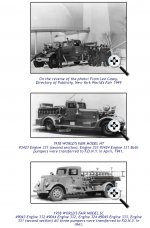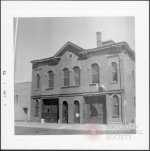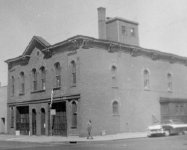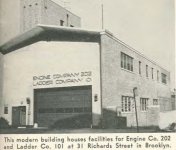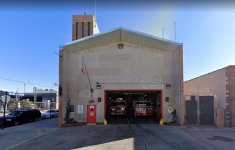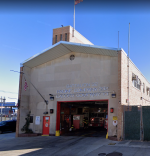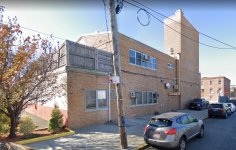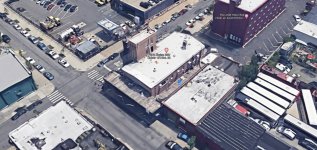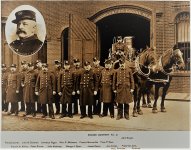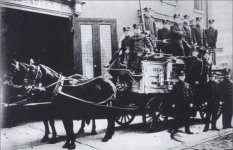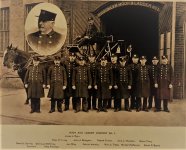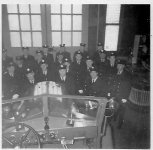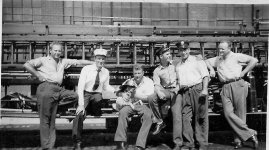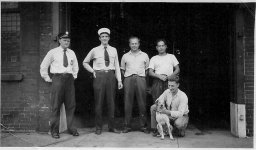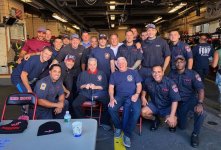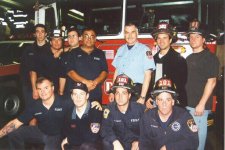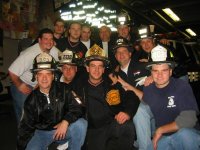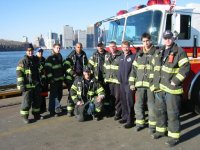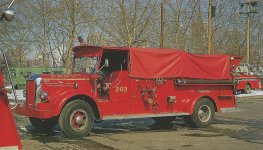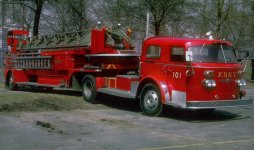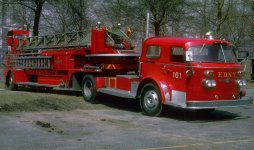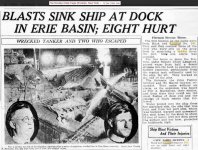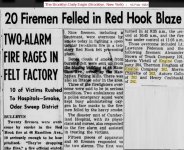You are using an out of date browser. It may not display this or other websites correctly.
You should upgrade or use an alternative browser.
You should upgrade or use an alternative browser.
FDNY and NYC Firehouses and Fire Companies - 2nd Section
- Thread starter mack
- Start date
- Joined
- May 6, 2010
- Messages
- 17,475
Not all wood frames....some brick MDs also & some commercial.....most did burn down.Looking on Google maps at L175 old quarters on New Jersey Ave, it appears the firehouse is one of the few buildings still standing on the street. Was that block all wood frames that burned during the war years?
- Joined
- May 6, 2010
- Messages
- 17,475
In regard to rely # 4076 above .....the Preventive Maintenance Unit mentioned was planned for the separate Bay (the red roll down on the left in the front of the FH picture ) separate from the FH interior.... A COMPLETE FLOP....the ceiling inside it turned out to be too low when an ENG or LAD was placed on the in ground lift....it was used for awhile only to do Preventive Maintenance of Chief Cars then used by Fire Prevention to do inspections on civilian Tank Trucks (not on the lift) that required an FDNY Permit....the separate bay did have Front & Rear access like a drive thru. ....the FH was also built to house a BN .....the only BN ever there for awhile was Safety BN*2 which was later disbanded.....Rescue Services the SOC forerunner also had been Quartered there at one point before the S*B .....later a RAC Unit was put there....the FH plot goes from Bradford St thru to Miller Ave....the FH was built without a Hose Tower & no heat to speak of on the Apparatus Floor Rig area except some inadequate ceiling Units .....in the extreme cold at times frozen Hose could not be thawed on the Apparatus Floor so a plug in heater was placed in one of the Pole Hole enclosures & the Hose hung in there....the ENG & LAD Office was on the ground floor off the Apparatus area ( so no up & down the stairs between Runs ).
Last edited:
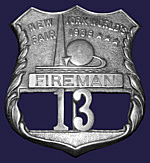
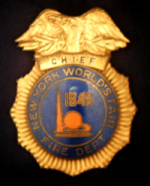
55th Battalion
Initially, the New York World's Fair Corporation planned to establish its own fire department at the fairgrounds in Flushing Meadow Park. They hired Thomas F. Dougherty to lead this department. Dougherty, a member of the FDNY from 1888 through 1932, was a former Assistant Chief, a Bennett Medal Winner, and the namesake of an FDNY valor medal. The Corporation purchased five pumpers from the Ahrens-Fox company. At some point, the New York World's Fair Corporation decided not to man the equipment with its own firefighters. In September 1938, the FDNY 55th Battalion was formed and stationed at the Fair to man the apparatus. It included three Battalion Chiefs, fourteen company officers, and seventy firemen manning one double and two single engine companies. In addition, sixty-five "Fire Guards" were organized under the direction of Chief Dougherty.
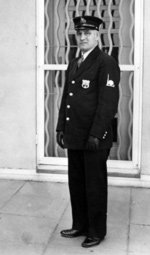
The Fire Guard was a private force of retired FDNY members hired by the New York World's Fair Corporation. They operated in a fire prevention capacity, inspecting buildings and patrolling the grounds during the hours that the Fair was open to the public. The Battalion and the Fire Guard were disbanded in 1940 shortly after the close of the Fair. The apparatus was given to the FDNY.
For the only time in FDNY history, the emblem of a private entity was affixed to the uniform of firefighters. Men assigned to the companies stationed at the World's Fair worn the distinctive Trylon and Perisphere on the left arm of their dress blues. FDNY Commissioner McElligott opposed this embellishment but at some point he relented.
Record of The 55th Battalion
Article published in the July Issue of the NY Fire Department magazine "WNYF" (1941)
Thanks again to Gary Urbanowicz, a New York City Fire Department Historian for his research and contribution to this site and the history of the NY Fire Department at the 1939 New York World's Fair.
The diligent work and the excellent record of our World's Fair companies should not be allowed to slide unnoticed into the obscurity of forgotten history. Up to now any praise would have been premature and spoken with crossed fingers. For, although the public crowds filed out of the gates for the last time eight months ago, the Fair grounds, buzzing with the activity of vans moving valuable contents from buildings, of wreckers tearing down the structures and of trucks carting away salvaged material, have continued as a responsibility for the New York Fire Department. But, now that the transformation of the area into Flushing Meadow Park is well under way, the record of the lately disbanded 55th Battalion should be told.
The temporary and combustible nature of its construction contrasted with the wealth of its furnishings and contents made the Fair a unique fire hazard. The $155,000,000 spectacle was spread over 1,216 acres. With the exception of three fireproof buildings, the general construction of the 150 major structures and the 40 smaller units was of steel frame, wood beams and studs, plasterboard, and wire lath with a stucco finish. Most of the structures in the amusement section and many in the exhibition area such as the Japanese Pavilion and the Horticulture Building, were made completely of wood. There were no fireproof roofs and in the large building vast quantities of lumber were exposed in spacious cocklofts. Cellars were rare. Wooden floors laid on planking supported by building piles, with a 3-foot space between the ground and the flooring represented a menacing fire condition.
The 55th Battalion was organized on September 5, 1938, for the sole purpose of protection life and property at the Fair. Its personnel consisted of 3 Battalion Chiefs, 14 company officers and 70 firemen assigned to one double and two single engine companies. From the beginning, commanding officers devoted their entire time to a study of potential fire fighting problems resulting from the unusual construction and equipment of the buildings. In addition to learning the location of hydrants and of auxiliary fire appliances and the peculiarities of each structure, the firemen, before the public opening of the exposition, drilled daily in stretching lines into buildings, cocklofts and towers. Other companies, in the vicinity, received instructions on the special tactics necessary for efficient duty at the Fair.
A private corps of 65 Fire Guards, made up of retired members of the New York Fire Department, under the command of Ex-Assistant Chief of Department Thomas F. Dougherty, supplemented the work of the firemen. They performed fire prevention duties, inspected buildings and streets, patrolled the grounds continuously and cooperated in every way with the Department.
The Journals of the 55th Battalion, during its brief existence of 32 months, disclose a total of 237 alarms received of which 166 were for actual fires. These figures can be separated into 5 periods: preceding the formal opening of the Fair, 38 call produced 29 fires; during the first open season 86 runs accounted for 63 "workers;" while closed for the following winter 20 alarms caused 6 actual fires (firemen patrolling the grounds in this same period, summoned to 27 additional locations, extinguished 21 blazes); the 1940 season brought 45 responses and 26 fires and finally 48 runs effected 42 fires in the time between the closing of the exposition and the disbanding of the battalion. None of the 4 extra alarm fire occurred while the Fair was open to the public.
The response to these alarms was through narrow roadways usually congested with sight-seeing buses and throngs of patrons. Not one person was injured during the entire period, nor did the apparatus sustain any damage. There was no need of preferring disciplinary charges against any member of the companies.
Article published in the July Issue of the NY Fire Department magazine "WNYF" (1941)
Thanks again to Gary Urbanowicz, a New York City Fire Department Historian for his research and contribution to this site and the history of the NY Fire Department at the 1939 New York World's Fair.
The diligent work and the excellent record of our World's Fair companies should not be allowed to slide unnoticed into the obscurity of forgotten history. Up to now any praise would have been premature and spoken with crossed fingers. For, although the public crowds filed out of the gates for the last time eight months ago, the Fair grounds, buzzing with the activity of vans moving valuable contents from buildings, of wreckers tearing down the structures and of trucks carting away salvaged material, have continued as a responsibility for the New York Fire Department. But, now that the transformation of the area into Flushing Meadow Park is well under way, the record of the lately disbanded 55th Battalion should be told.
The temporary and combustible nature of its construction contrasted with the wealth of its furnishings and contents made the Fair a unique fire hazard. The $155,000,000 spectacle was spread over 1,216 acres. With the exception of three fireproof buildings, the general construction of the 150 major structures and the 40 smaller units was of steel frame, wood beams and studs, plasterboard, and wire lath with a stucco finish. Most of the structures in the amusement section and many in the exhibition area such as the Japanese Pavilion and the Horticulture Building, were made completely of wood. There were no fireproof roofs and in the large building vast quantities of lumber were exposed in spacious cocklofts. Cellars were rare. Wooden floors laid on planking supported by building piles, with a 3-foot space between the ground and the flooring represented a menacing fire condition.
The 55th Battalion was organized on September 5, 1938, for the sole purpose of protection life and property at the Fair. Its personnel consisted of 3 Battalion Chiefs, 14 company officers and 70 firemen assigned to one double and two single engine companies. From the beginning, commanding officers devoted their entire time to a study of potential fire fighting problems resulting from the unusual construction and equipment of the buildings. In addition to learning the location of hydrants and of auxiliary fire appliances and the peculiarities of each structure, the firemen, before the public opening of the exposition, drilled daily in stretching lines into buildings, cocklofts and towers. Other companies, in the vicinity, received instructions on the special tactics necessary for efficient duty at the Fair.
A private corps of 65 Fire Guards, made up of retired members of the New York Fire Department, under the command of Ex-Assistant Chief of Department Thomas F. Dougherty, supplemented the work of the firemen. They performed fire prevention duties, inspected buildings and streets, patrolled the grounds continuously and cooperated in every way with the Department.
The Journals of the 55th Battalion, during its brief existence of 32 months, disclose a total of 237 alarms received of which 166 were for actual fires. These figures can be separated into 5 periods: preceding the formal opening of the Fair, 38 call produced 29 fires; during the first open season 86 runs accounted for 63 "workers;" while closed for the following winter 20 alarms caused 6 actual fires (firemen patrolling the grounds in this same period, summoned to 27 additional locations, extinguished 21 blazes); the 1940 season brought 45 responses and 26 fires and finally 48 runs effected 42 fires in the time between the closing of the exposition and the disbanding of the battalion. None of the 4 extra alarm fire occurred while the Fair was open to the public.
The response to these alarms was through narrow roadways usually congested with sight-seeing buses and throngs of patrons. Not one person was injured during the entire period, nor did the apparatus sustain any damage. There was no need of preferring disciplinary charges against any member of the companies.
- Joined
- Jun 27, 2007
- Messages
- 3,739
A cold, and for many, a very snowy day. The perfect time to sit and follow this thread.
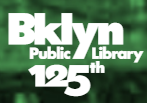
Engine 202 Ladder Company 101 fire fighters on truck 1925
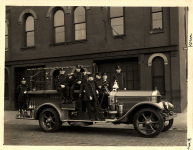
Engine 202 Ladder Company 101 fire fighters on truck, 1925 ca.
This week we honor the first responders in Emergency Medical Services (EMS) -- the paramedics, emergency medical technicians, and the Fire Department of the City of New York -- who provide all kinds of vital pre-hospital care. Thank you!
This gelatin silver print of firefighters from the Fire Department of the City of New York (FDNY), Engine 202, Ladder Company 101 was taken around 1925. At the time of the photograph, the fire station for FDNY, Engine 202 was located at 199 Van Brunt Street in Red Hook, Brooklyn. In the print, firefighters wear formal dark uniforms with hats and appear on a fire truck whose steering wheel is located on the right side of the vehicle.
Engine Company 202 was originally founded as Engine 2 of the Brooklyn Fire Department on September 15, 1869. Engine 2 was one the original thirteen Engines, and six Ladders, that were created with the formation of the Brooklyn Fire Department. Over the next 90 years, the company’s name would change multiple times. With the formation of the Greater City of New York on January 1, 1898, Brooklyn became a borough within NYC. Twenty-eight days later on January 28, 1898, the Brooklyn Fire Department became part of the FDNY, and the name of the company was changed to FDNY, Engine 2. The unit would undergo another name change to FDNY, Engine 102 on October 1, 1899 when the FDNY renumbered companies in Brooklyn and Queens to avoid confusion with Manhattan and Bronx companies that shared the same numbers. The FDNY underwent a second major reorganization in 1913. With the reorganization came the company’s name change to FDNY, Engine 202 on January 1, 1913.
Engine Company 202 moved to its current fire station at 31 Richards Street on March 10, 1960. Due to the company’s proximity to the Brooklyn-Battery Tunnel, Engine 202 was one of the first units to arrive at Ground Zero during the 9/11 terrorist attacks. On that day, Engine 202 and Ladder 101’s trucks were destroyed, and all seven members of Ladder 101 were killed. During the weeks and months that followed, many members of the unit volunteered to shift through the rubble of the site looking for survivors and helping with the cleanup process.
Engine Company 202, Ladder Company 101 continues to be at the forefront of responding to any disaster that strikes New York City. With the spread of COVID-19 in 2020, members of the company are some of the first people to respond to New Yorkers’ emergency calls. This week we honor their, and all EMS workers', commitment and sacrifice to help New Yorkers during this global healthcare crisis.

